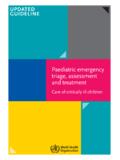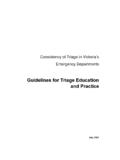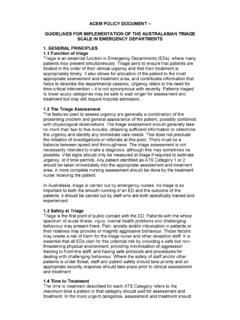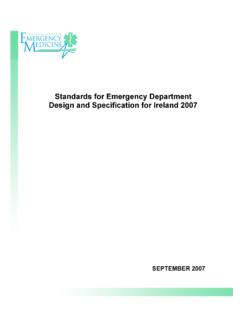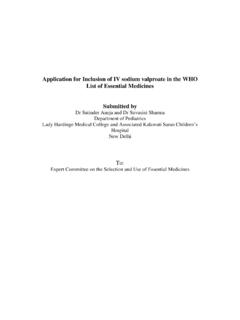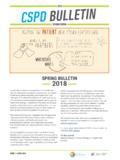Transcription of For further information, please contact: participants - WHO
1 emergency TriageAssessmentandTreatment(ETAT)Manual forparticipantsWorld HealthOrganizationFor further information , please contact :Department of Child and Adolescent Health and Development (CAH)World Health Organization20, Avenue Appia1211 Geneva 27 SwitzerlandTel: +41 22 791 2632 Fax: +41 22 791 4853E-mail: site: 92 4 154687 5 emergency triage assessment and treatment (ETAT) Manual for participants WHOIEMERGENCY triage assessment AND TREATMENTE mergency TriageAssessmentandTreatment(ETAT)Manual forparticipantsWorld HealthOrganizationAcknowledgementsThe WHO Department of Child and Adolescent Health and Development wishes to acknowledge thehelp and support of Professor Elizabeth Molyneux, who developed the training course for the EmergencyTriage assessment and treatment on which these course materials are based. We would like to extend ourthanks to Patricia Whitesell, ACT, USA, who wrote a first draft of the materials, and to Dr.
2 Jan Eshuis,Royal Tropical Institute, Amsterdam, who developed the training materials further . In addition, we aregrateful to the participants and facilitators of several field tests of these materials for their comments. Wewish to thank Dr Carolyn Maclennan, Melbourne, Australia, Dr. Diana Silimperi and Lauri Winter,Quality Assurance Project, Bethesda, USA for providing substantial comments and revisions during thesefield tests, and the WHO Regional Offices for Africa, Southeast Asia and the Western Pacific for Library Cataloguing-in-Publication DataEmergency triage assessment and treatment (ETAT).Contents: Manual for participants Facilitator triage . 2. emergency treatment . 3. Child health services. 4. Teaching materials. I. World 92 4 154687 5 ( participants )(NLM classification: WS 205)ISBN 92 4 154688 3 (facilitator) World Health Organization 2005 All rights reserved. Publications of the World Health Organization can be obtained from WHO Press,World Health Organization, 20 Avenue Appia, 1211 Geneva 27, Switzerland (tel: +41 22 791 2476; fax:+41 22 791 4857; email: Requests for permission to reproduce or translate WHOpublications whether for sale or for noncommercial distribution should be addressed to WHO Press,at the above address (fax: +41 22 791 4806; email: designations employed and the presentation of the material in this publication do not imply theexpression of any opinion whatsoever on the part of the World Health Organization concerning the legalstatus of any country, territory, city or area or of its authorities, or concerning the delimitation of itsfrontiers or boundaries.))
3 Dotted lines on maps represent approximate border lines for which there may notyet be full mention of specific companies or of certain manufacturers products does not imply that they areendorsed or recommended by the World Health Organization in preference to others of a similar naturethat are not mentioned. Errors and omissions excepted, the names of proprietary products are distinguishedby initial capital reasonable precautions have been taken by WHO to verify the information contained in this , the published material is being distributed without warranty of any kind, either express orimplied. The responsibility for the interpretation and use of the material lies with the reader. In no eventshall the World Health Organization be liable for damages arising from its inIIIEMERGENCY triage assessment AND TREATMENTT able of contentsIntroduction1 Learning objectives for the training course2 Module One: triage and the ABCD concept3 The ABCD concept4 Priority signs4 The triaging process4 When and where should triaging takes place?
4 5 Who should triage ?5 How to triage ?5 Assessing priority signs6 General treatment for priority signs8 The need for frequent reassessment9 assessment questions:Triage10 Module Two: Airway and breathing13 assessment of the airway13Is the child breathing? Is the airway obstructed?13 Management of the airway14 Management of the choking child14 Positioning to improve the airway15Is trauma of the neck a possibility?16 assessment breathing17Is the child breathing?17 Does the child show central cyanosis?17 Does the child have severe respiratory distress?18 Management of breathing problems18 Ventilate with bag and mask18 Insertion of an oropharyngeal (Guedel) airway19 Give oxygen20 assessment questions: Airway and breathing23 Module Three: Circulation25 Assess the circulation26 Are the child s hands warm?26Is the capillary refill longer than 3 seconds?26Is the pulse weak and fast?27 Shock27 treatment of shock27 assessment questions: Circulation32 IVModule Four: Coma and convulsion35 Assess the child s neurological status35Is the child in coma?
5 35Is the child convulsing now?36 treatment of coma and convulsion36 Manage the airway37 Position the child37 Check blood sugar37 Give IV glucose38 Give an anticonvulsant39 assessment questions: Coma and convulsion41 Module Five: Dehydration43 Assess for severe dehydration43Is the child lethargic44 Does the child have sunken eyes?44 Does a skin pinch go back very slowly (longer than 2 seconds)?44 treatment of severe dehydration in an emergency setting45 Severe dehydration (without shock or severe malnutrition)45 Give fluids by nasogastric tube if you cannot set up an intravenous infusion45 Severe dehydration with severe malnutrition47 assessment questions: Dehydration49 Module Six: Case management scenarios53 Module Seven: Implementing ETAT55 Objectives of the chapter/session55 Implementing ETAT in your hospital56 Advocacy56 Patient flow and tasks57 Material resources57 Developing individual plans of actions57 AnnexesAnnex 1. Practical procedures59 Giving parenteral fluids59 Insertion of a nasogastric tube63 Annex 2.
6 Resources required to implement emergegncy care of children in hospitals65 Annex 3. ETAT charts67 Chart 2: triage of all sick children67 Chart 3:How to manage a choking child69 Chart 4:How to manage the airway in a child with obstructed breathing(or who has just stopped breathing)70 Chart 5:How to give oxygen71 Chart 6:How to position the unconscious child72 Chart 7:How to give IV fluids rapidly for shock in a child without severemalnutrition73 Chart 8:How to give IV fluids for shock in a child with severe malnutrition74 Chart 9:How to give diazepam (or paraldehyde) rectally75 Chart 10: How to give IV glucose76 Chart 11: How to treat severe dehydration in an emergency setting771 emergency triage assessment AND TREATMENTI ntroductionA nine-month old baby boy is carried into the children s section of the outpatientdepartment in his mother s arms. He appears to be asleep. At the triage desk heis seen by a nurse and found to have lips and tongue that are grey/blue in colour,and he is taken straight into the resuscitation room as an the resuscitation room he is given oxygen from an oxygen concentrator.
7 He isnoted to be grunting and breathing very fast. His hands are cold to touch andthe capillary refill time is prolonged to four seconds. An intravenous cannula isplaced. A blood sample is taken at the same time for blood glucose, haematocritand other investigations. An intravenous infusion of normal saline is commencedat 20ml/kg to run as fast as it can treatments are given, depending on the result of the investigations andthe response to the treatment he receives. It is now 18 minutes since the babycame through the outpatient department s door, and his situation is stable. It isnow time to take a full history and carry out a full examination to make adefinitive diagnosis. He is diagnosed as having very severe pneumonia, andreceives specific treatment for this. However, before coming to this diagnosis,no time was wasted, his status was stabilized, based on a few leading signs andsymptoms, even when the medical staff did not know exactly what was wrongwith was good triage and emergency management.
8 Would it have happened likethis in your hospital? In this training course, you are going to acquire the necessaryknowledge and skills for the triage and emergency management of sick children,and you will consider what is needed to introduce this to your in hospital often occur within 24 hours of admission. Many of thesedeaths could be prevented if very sick children are identified soon after theirarrival in the health facility, and treatment is started immediately. Therefore, aprocess of rapid triage for all children presenting to hospital needs to be put inplace, to determine whether any emergency or priority signs are present. Triagemay be done in 15-20 seconds by medical staff or by non-medical staff (afterappropriate training) as soon as the child arrives, and no special equipment isneeded for this. Once emergency signs are identified, prompt emergency treatmentneeds to be given to stabilize the condition of the has developed emergency triage assessment and treatment (ETAT)guidelines.
9 These are adapted from the Advanced Paediatric Life Supportguidelines used in western countries, and they identify children with immediatelylife-threatening conditions which are most frequently seen in developingcountries, such as obstruction of the airway and other breathing problems causedby infections, shock, severely altered central nervous system function (coma orconvulsions), and severe guidelines were developed in Malawi, and were field-tested in severalother countries including Angola, Brazil, Cambodia, Indonesia, Kenya and guidelines are contained in the manual Management of the child with aserious infection or severe malnutrition and in the Pocketbook of hospitalcare for children , on which this training course is based. This course manual isprimarily meant for the participants of a 3 1/2 days training course in EmergencyTriage, assessment and treatment . It provides participants with the readingmaterials to prepare themselves for the modules taught in the course.
10 Some ofthe reading might be done during the course. In addition, it gives questions forself- assessment which participants can respond to after having gone through thetraining. Apart from use in a full-time training course, the reading will be usefulfor trainers and participants who take part in training as a series of on how to conduct such training is contained in a parallel facilitator training course does not stand on its own. It can be included in a qualityimprovement process which targets the whole hospital or it can start such aprocess. At the end of the course, participants plan for introducing an ETAT process at their institution, by comparing the existing situation with internationalstandards, and suggesting actions to solve identified problems and to documentand evaluate such a process. Lessons learned in this process can be applied toother areas of child health in hospital and to care of other patient management is by team, rather than by individual players, so teamwork is emphasized and practised throughout the objectives for the training courseAt the end of the course you will be able to: triage all sick children when they arrive at a health facility, into thefollowing categories:- those with emergency signs- those with priority signs- those who are non-urgent cases.










